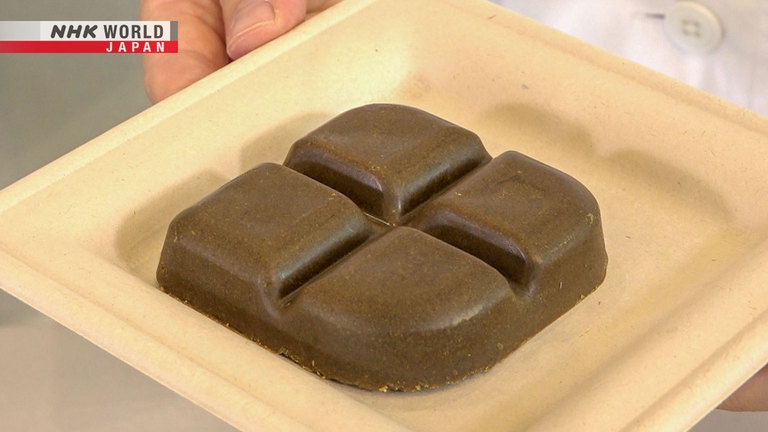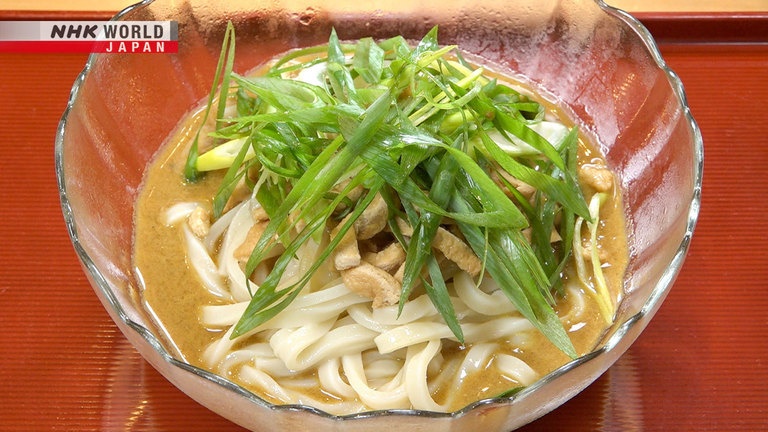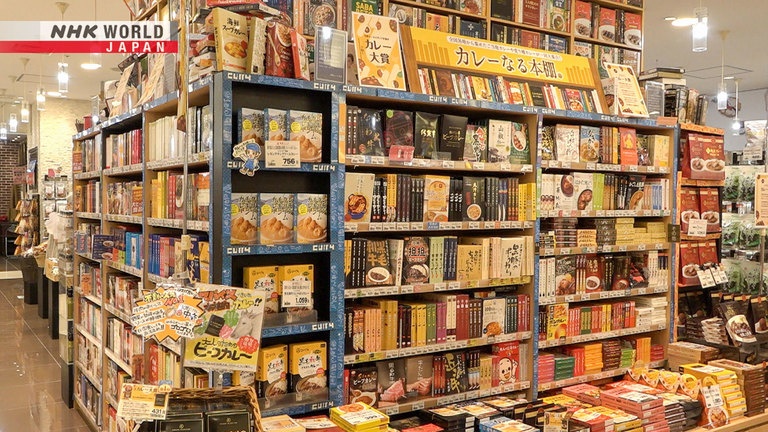JAPANESE CURRY
Curry in Japan mainly comes as a thick sauce poured over white rice. With the development of roux cubes, curry rice became easy to make at home and in schools, launching the food into national stardom. Specialty shops across the country also began cooking up their own versions of the popular dish. Once ready-to-eat pouched food hit the market, Japanese curry became a tasty regional souvenir. Discover more about the unique world of Japanese curry! (Reporter: Jason Hancock)




Transcript
Tokyo: this world-class metropolis is a veritable gourmet wonderland.
Discover the stories behind the ingredients that make this city so delicious - so "oishii."
This time, it's all about Japanese curry!
Curry is a world-famous food, loved for its rich aroma and combination of stimulating spices.
The Japanese version is so popular, it's widely considered a national dish.
Anyone who grew up in Japan likely made some during field trips or in cooking classes at school.
Different types of curry are eaten and loved across the globe.
In Japan, curry is served as "curry rice"
- a thick roux of spices and other ingredients is poured over soft white rice.
In a food culture built on pairing tasty foods with rice
- the country's staple-curry quickly found its way into the country's collective heart.
"Oishii."
Experimentation has led to some uniquely Japanese recipes.
Discover more about Japanese curry, one of the nation's top soul food dishes.
Trails to Oishii Tokyo.
Hello, everyone. I'm Jason Hancock.
On this episode, we are going to learn about curry.
I actually had never tried curry until I came here to Japan, and now it's one of my favorite foods.
I'm very excited to learn more about my favorite food, curry.
Jason begins in Kanda-Jinbocho, Tokyo.
The area is mostly known as a book town, home to many publishers and used book stores.
However...
It's also a famous curry spot.
You'll find over 400 restaurants with curry on the menu.
"You can actually smell the curry here."
So, here's one curry restaurant.
Here is another curry restaurant,
and another curry restaurant, and another curry restaurant.
So, in this part of Tokyo, there are many kinds of curry restaurants and it smells amazing.
Jason picks a shop that's popular with overseas travelers.
Here you go. Enjoy.
It looks great!
This is "katsu" curry.
A fried pork cutlet, called "tonkatsu," is placed over rice, with curry poured on top.
Looks so good.
It is amazing. The spices are perfectly spicy.
It's not too spicy. It's not too sweet. It's perfect.
And on top, we have a 'tonkatsu,' or pork cutlet, which is perfectly fried.
And when you eat it on rice, it's something that makes me feel like I'm in Japan.
"Katsu" curry is our most popular dish by far.
But it's very filling, so it's not for the faint of heart!
"Tonkatsu" itself is a local favorite that tourists also love.
Pouring curry on top gave birth to a new icon of Japanese cuisine.
"Katsu" curry is a hit in the UK as well.
The main difference lies in the use of chicken instead of pork,
but the dish is still lovingly referred to as Japanese curry.
Many overseas visitors come to this shop to try authentic "katsu" curry, using fried pork.
Curry came from England to Japan around 150 years ago.
Here, curry recipes are shown in a Western cookbook of the time.
After that, restaurants serving Western food catered to the Japanese palate opened across Japan.
Curry rice became a mainstay on Western menus, and won over the hearts of the Japanese people.
Jason's next stop is Hibiya Park, near the Imperial Palace.
Japan's first-ever Western park, created 120 years ago, is still popular with locals.
This restaurant has been here since the beginning.
- Beef curry. Enjoy.
- Looks wonderful.
It smells good too!
The recipe hasn't changed since we opened.
- The same for 120 years?
- That's right.
That's unreal.
"Itadakimasu."
Wonderful flavor.
The meat is so tender.
- Japanese curry is different
from that of India or Thailand.
- I agree.
It's Western food with a Japanese twist.
Japanese-style Western food.
Here's a closer look at the classic, unchanged recipe.
First, curry powder is cooked in oil.
Over high heat, the aroma comes out.
Flour is added to thicken it.
The mixture is heated in the oven to cook out moisture.
This curry base is then left to sit overnight.
The next day, it's mixed with water to make a sauce, which is also left to sit overnight.
On day 3, beef rib meat is fried up and added to the sauce.
On day 4, the sauce is ready after thorough stewing.
Each step of the process deepens the flavor, for a rich, full-bodied curry sauce.
Indian curry doesn't contain flour,
so it's less thick, and spicier.
We use flour to thicken the sauce
so that it coats and sticks to rice.
- You make it to pair well with Japanese rice?
- Yes.
- Japanese people love rice,
so the curry needs to be tasty with it.
- Yes.
- No wonder they love curry so much.
- Right.
Japonica rice, eaten in Japan, is characterized by a sticky and plump texture.
Thickening curry sauce with flour allows it to envelope the rice, rather than be soaked in.
This enhances the flavor of the rice without altering its texture.
The key to a great Japanese curry sauce lies in the curry powder that's used.
In India, curry's motherland, it's common to use an array of spices when cooking.
They're chosen based on personal preference and climate, ground,
and then blended to make all kinds of food.
In 18th-century England, where spices were less common,
curry powder was developed to make cooking curry easier.
Basically, it's a selection of spices made into a powder.
Jason visits a major Tokyo manufacturer's in-house museum to find out more.
Along with information about various spices, it details the history of Japanese curry.
- Do you know what curry powder is made of?
- Curry powder? Uh...
- No idea.
- Back in the day, we didn't know either.
- So it's not just me!
- Everyone was wondering what it was.
They thought it might come from making
parts of the curry tree into a tasty powder.
When first introduced in Japan, curry powder was an expensive luxury imported from England.
The company's founder, Yamazaki Minejiro, began blending spices from around the world,
eventually creating the company's first curry powder.
It was released in 1923.
With a more affordable ingredient on hand, restaurants were able to launch curry rice into stardom.
Curry powder usually contains seven key spices.
Are these the base ingredients?
Right.On this side are the whole spices.
Next to that are the spices in ground form.
Spices mainly offer three things: pungency, color and aroma.
Chilies and black pepper are common choices for pungency.
Turmeric is known for giving food a distinct yellow color.
It also helps bind flavors together.
Then, there's aroma. Different spices offer their own unique aromas.
Nice aroma.
It's a bit like mustard.
This has a sweet aroma, a bit like lemon.
Jason tries blending the seven spices.
With each one I add, the aroma keeps building up.
They have their own strengths,
but mixing them creates a wonderful synergy.
Definitely.
So nice.
Time to check the aroma of the company's curry powder.
This has a stronger curry smell.
We sell this curry powder in Japan.
It's a blend of over 30 herbs and spices.
The previous one only had 7...
- And this has over 30.
- What's in it?
The answer is...a trade secret.
Can't tell me?
The recipe is a guarded secret: only a few people in the company actually know.
The company currently holds over 70% of the domestic curry powder market.
British curry powder typically consists of around 10 spices,
as opposed to over 30 used for Japan's novel product!
It's said that their product was the foundation of Japanese curry,
as restaurants across the country began using it in earnest.
This curry roux product was developed in the 1950s.
The cubes made it easier for people to make curry at home.
As you saw before, curry powder
is a blend of herbs and spices.
This also contains various seasonings,
so you just dissolve it to make tasty curry.
The cubes are made of curry powder, flour for thickening,
"umami" ingredients, and other seasonings.
Just throw them in a pot of water with other ingredients.
It revolutionized curry consumption, taking the dish out of restaurants and into the common household.
Jason gets a cooking lesson.
He'll work with common kitchen ingredients: onions, potatoes, carrots, and meat.
- Bite-sized?
- Maybe slightly larger, like this.
Got it.
Can I cut it my own way?
It's making me nervous, but go ahead.
- I hope I'm not offending you.
- You're fine.
Stir fry the veggies over medium heat for about 10 minutes to bring out their sweetness.
Then add water, bring it to a boil, and let it simmer for 20 minutes.
When the ingredients are cooked through, add the curry cubes.
The cubes have indentions, so it's
easy to break them into four pieces.
Hold it and break it once...twice,
so it looks like this?
Looks like chocolate.
Turn off the heat before adding the cubes.
That keeps the sauce from getting lumpy.
Smells like curry. Nice!
After the cubes melt, simmer the curry over low heat until it thickens.
Looks great!
"Itadakimasu."
"Oishii."
- You can't go wrong using the cubes.
- Right.
Anyone can make tasty curry this way!
Homecooked curry made easy.
This took curry rice to a whole new level, turning it into a national favorite.
But another product made things even easier.
Curry in a pouch!
Boil the pouch in water, and pour out the steaming curry!
Jason heads to a store with a wide selection.
Wow. There are a lot of kinds of curry here.
It looks like a library of curry.
Look, all the way up to the ceiling.
It's curry, curry, curry...
As a curry lover, this is heaven for me. Okay.
Lemon cream chicken curry? What?
Oyster curry? What?
Wow. Here is some more. What?
Blue curry. Red curry.
This looks like ketchup and this looks like a cocktail.
How many types do you have here?
About 370.
That many?
Eating one per day would take over a year!
Right, you could try a new one every day.
Ready-to-eat pouched food was developed in the 1950s for the US military.
A Japanese manufacturer took notice and adopted the technology.
Then, they released something to the general public in 1968.
It was...you guessed it...
curry in a pouch!
Many varieties appeared on the market soon after.
In recent years, products made with regional ingredients have grown especially popular.
This contains "wagyu" beef tail from Nagasaki.
This one has oysters from Hiroshima.
The great thing about curry is that you can put in pretty much whatever you want.
The regional curries have become popular souvenirs.
You seem to have something for everyone.
Right. You're bound to find something you like.
Jason's next stop is a bakery established over 100 years ago.
Freshly-fried curry bread.
Be careful, it's hot.
Looks and smells wonderful.
So, this is "curry-pan," or curry bread.
And before coming to Japan, I had never seen anything like this.
- "Itadakimasu."
- Enjoy.
"Oishii!"
If you look inside, you can see the curry inside the bread.
Now...and the inside of the curry bread is very soft
and the outside has been cooked in oil, so it's crunchy.
So there's the balance between the crunchy and the soft,
and the sweet and spicy, and oh, it's so good.
Curry bread came onto the scene about 100 years ago.
It was inspired by fried pork cutlets and curry, which, as you know, were very popular at the time.
The curry has fine bits of carrot, onion, and ground pork.
And it's not too spicy, so kids love it too.
The curry is wrapped in dough.
It's then breaded like a pork cutlet and deep-fried for about three minutes.
Once golden-brown, it's ready!
- How many do you make each day?
- 1,000 per day.
They sell a lot of baked goods, but curry bread is the top seller by far.
Nowadays, curry bread is sold at bakeries all over Japan, and it has a lot of devout fans.
On his final stop, Jason will try another Japanese curry classic.
Thank you very much.
So, now I am having a dish called curry "udon."
And even though I've been in Japan for years, I still think this combination is a little strange.
It's not like spaghetti where there's noodles and soup, it's curry.
And the noodles are the Japanese "udon" noodles, which are very big.
So, it tastes delicious, of course.
But there's something different about this curry
that I haven't experienced in the last few days.
The spices are still there,
but there's something soft about this flavor.
Is there something different
about curry used for "udon?"
Noodles come in broth, right?
The curry is mixed with the broth.
Udon noodles come in bonito broth seasoned with soy sauce and "mirin."
Curry paste is then added, making an "umami"-packed curry soup.
This shop adds milk at the end.
This makes it milder and easier to drink once the noodles are gone.
The bonito stock and soy sauce
make it a truly Japanese dish.
Curry udon can be a little messy, so they offer paper bibs to keep your clothes from getting splashed.
Next up is "cold curry udon" which they only serve in summer.
Have you ever tried cold curry?
- I don't think so.
- Me neither, until we started serving it.
- "Oishii."
- Great to hear.
Perfect for a hot day like today.
The cold soup, made with little oil, is mild and refreshing.
Whether you like it hot and spicy, or cold and refreshing,
Japanese curry has come a long way over the last 100 years.
And it continues to evolve.
Before this experience, I could say that I liked curry,
but now, because I've learned so much in the last few days, I can say that I love curry.
There are so many ways to eat it; you have curry rice, you have curry "pan," you have curry "udon"...
And with the many variations of curry itself, there's a curry for everyone.
And that's why I think the Japanese people like curry.
In Tokyo, every ingredient has its own story.